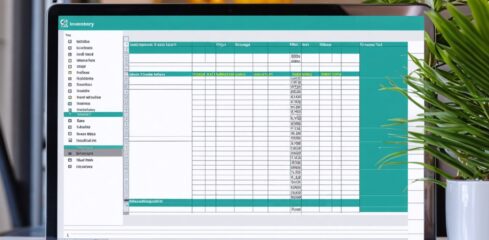

If you are looking for ways to improve your business, consider starting with your inventory management system. Taking control of your merchandise has become easier with the help of modern technology, like specialized software platforms designed to give accurate and efficient insights into the flow of your goods. We are breaking down 10 tips for enhancing your inventory practices and, ultimately, your company.
Learn more about how your business can improve its inventory management systems.
The Importance of Effective Inventory Management
Inventory is among the most valuable and important assets of a business. No matter your company’s size and scale, utilizing proper management techniques is helpful for maximizing your revenue and keeping your operations running.
Effective inventory management can reap the following benefits:
- Improved accuracy: From future planning to order fulfillment, having an accurate picture of your business’s inventory is highly beneficial. You wouldn’t want to send the wrong items to customers or have them put in an order for a product that is out of stock.
- Greater efficiency: Good inventory management allows for faster processes. Whether you’re pulling merchandise for a customer or planning your next order, you can make accurate judgments more quickly when you have a complete understanding of your current inventory.
- Minimized storage needs: Holding inventory in your warehouse costs your business valuable space and money. With effective inventory management, you can reduce storage quantities, especially for slow-moving merchandise.
- Better planning: You need accurate planning to scale your operation effectively. Having insights into your inventory will help you make better business decisions that uplift your operation and support growth.
- Improved customer satisfaction: One of the greatest advantages of good inventory practices is enhanced customer relationships and satisfaction. Your shoppers do not want to wait for their items or deal with inaccurate orders. Proper inventory management helps keep your customers happy and interested in returning to your business.
Utilizing outdated inventory management techniques can be detrimental to your operation. Prioritizing effective practices is useful for improving your company and serving your customers.
The Effects of Poor Inventory Management
Maintaining efficiency with inventory management is vital. Lack of proper inventory management can lead to decreasing revenue with the loss of customers and products. Understanding the following consequences of poor inventory management can help you see when its time to prioritize efficiency:
- Losing customers: Customers appreciate speedy services that deliver results instantly. When they order products online, they want you to have them available always. When they see that an item you listed is out of stock after placing an order or while searching for products, they are more likely to abandon their orders than wait for you to restock. Instead, they will turn to your competitors, who can provide similar products and better customer services.
- Overstocking items: Overstocking items might help prevent shortages, but it can come with other downsides, like decreasing the product’s quality as it sits in storage. Further, you will often have to account for the extra costs of storing overstocked items. Sales, discounts and bulk orders can help clear space and get rid of products, but you might receive a lower revenue than expected.
- No tracking or forecasting trends: Inefficient inventory management makes it hard to accurately track and forecast trends because you need comprehensive historical data to make decisions when ordering products. This management style lacks the technological infrastructure required to support this tracking and ordering.
Poor inventory management can affect all levels of your business, from customer experience and satisfaction to your company’s revenue and costs. An efficient inventory management system can help you support your company in many ways.


10 Inventory Management Tips
Your inventory is a major part of your business and can determine whether your operation grows or fails. Consider the following tips for how to improve inventory management:
1. Automate Your Operations
Automation can help businesses organize and streamline tasks. You can set thresholds for specific products, and the system will automatically order a determined amount when product counts reach that threshold.
This system can help prevent your company from selling out on popular products, ensuring customers can always receive the goods they want. It can also help with less popular items, maintaining inventory levels when your attention might be on other products.
2. Implement One-Click Purchase Orders
One-click purchases allow your customers to order items immediately. When customers search for companies that provide immediate services and quicker results, you can give them what they’re after by simplifying the checkout and purchase process into one action.
Your customers will appreciate the effort you put into improving their experiences. Investments like these can help strengthen customer loyalty and your brand.
3. Centralize Tracking
Product and inventory tracking can help improve efficiency in many ways. Employees and managers need to know how much of each product they have available, so they can determine when to make orders.
By using a lot ID tracking system, your business can enjoy clear traceability of your merchandise. Tracking can also help preserve product quality. An advanced system can determine how long a product has been in storage, and it can organize products to ship older items first, optimizing their shelf lives.
A centralized system can help all employees understand each product’s vital information. When employees can access data about any product in one place, they can improve efficiency related to storing and shipping practices.
4. Use Accurate Demand Forecast Tracking
Automated systems can help track and analyze data about your products and business trends. When demand levels depend on past information, having a solution that can provide you with the reports you need to make decisions is vital.
Automated software can track demand trends on many levels, from monthly to annual reports. When you have access to extended trends on products, you can make more reliable and specific forecasts for future product fulfillment. Instead of general estimates, you can better determine exactly how much you’ll need.
5. Maintain Safety Stock
Safety stock is the practice of ordering more than you need to preserve your inventory in unpredictable circumstances. These situations can include sudden shifts in demand, damages and supplier delays. With a safety stock, you can continue filling orders while solving problems behind the scenes, keeping your customers happy.
However, safety stocks are different from overstocking. You will have to determine the balance between a safety stock and overstocking based on revenue and costs. This amount will depend on each company and warehouse, helping to meet their needs.
6. Audit Regularly
It’s important to perform regular audits to keep track of your inventory and ensure that your warehouse operations are running smoothly. These audits should include counting physical inventory once a year and spot-checking on an as-needed basis if you’ve had problems managing specific areas of your inventory.
Auditing can give your operation complete visibility into your current stock with accurate and comprehensive logs.
7. Implement Contingency Planning
Every business needs to have a contingency plan in place for unexpected changes, such as overselling stock, problems on the manufacturer’s end, cashflow shortage and similar scenarios. Being prepared for potential inventory challenges will save your business money when inevitable bumps in the road do occur.
8. Prioritize Warehouse Organization
Organization is the key to maintaining a functional storehouse. Your warehouse operators need to know where they can find any stored product at any time, and they need fast and easy access to it. The increased organization also enables you to track your stock and restock more efficiently, so you won’t run out of certain products when you need them.
9. Track Regional Demand
Knowing who’s buying your products and where is a determining factor in how you stock your inventory in specific warehouses. If you find that customers in a specific part of the country buy more of certain products than customers in a different region, you can adjust your warehouse product ratios to accommodate the demand.
10. Invest in the Right Inventory Management Software
The best way to manage inventory is with a software solution that centralizes management and tracks your merchandise for you. Businesses need highly organized systems to stay ahead of their inventory needs and keep up with changing customer demand.
As your business grows, you need an inventory management system that can keep up. If you’re looking for the right software system to help you improve your inventory management, check out Finale Inventory’s innovative, customizable solutions!


Make the Most of Your Inventory Management With Finale Inventory
Finale Inventory’s cloud inventory management software solutions give users the tools to manage their products in one centralized database that is designed to scale with your operation.
Our software can help your business access your most important data from any device so you are always on top of your inventory needs. Implementation is easy, as it integrates seamlessly with other enterprise platforms, including QuickBooks, Excel and Square.
Interested in learning more about Finale Inventory and how we can benefit your business? Schedule a demo or contact us today!
Last Updated on November 15, 2022 at 2:45 pm EST







